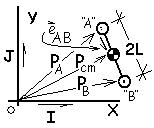| THERMO Spoken Here! ~ J. Pohl © | TOC NEXT ~ 163 |
3.22 Rotational Kinetic Energy

The simplest model of physical matter is the BODY which is an approximation of the selected matter as being localized at a point, that is, to have mass but no extent. For mass without extent, rotation makes no sense. Otherwise stated, a BODY does not rotate.
Our next model, a step more complex than the BODY, will consist of two identical masses of atomic size. We assume the masses locked side-by-side with a rigid, constant distance between them. It is usual to call these BODIES, PARTICLES and to call their configuration a RIGID BODY.
Two-Particle Rigid Body: The simplest model of "RIGID BODY" is the idea of matter (a system) composed of two BODIES (or particles) of equal masses located close together in a rigid arrangement. Some call these "dumbbell molecules" since they resemble weight lifter equipment. While neither BODY moves toward or away from the other, the BODIES move. The BODIES each have a center of mass and so does the pair, takentogether. We take the "combined center of mass" as a reference. Rigid too-particle BODIES exhibit rotational behavior and have rotational energy. Let us forgo how force is applied to a rigid body pair, disregard how the condition is attained.
The BODIES are labeled "A" and "B" and at the instant shown have the vector positions and velocities indicated. In these expressions, eAB(t) is a time dependent unit vector. It suits our purposes to restrict this discussion to an "in a plane" rotation which will show the results readily with easier mathematics.
For the two BODIES the kinetic energy is written as a sum:

| (1) 1 |
Now express the velocities, VA and VB as the the velocity of the center of mass plus a rotational component relative to the center of mass. We show the steps for particle "A."
Particle "A" is located and moves in the plane-0XY. The position of "A," referenced to the position of the center of mass of the A-B particle pair is written in general, Eqn-13. The relative velocity component (subscripted A/cm) equals the distance L/2 times a unit vector directed from the center of mass (of the pair) toward "A." That position vector is represented Eqn-013 - right.

| (13) 13 |
First, notice the direction "FROM" cm to "A" is in the negative, eA/cm(t) direction. Thus the minus sign. Now we combine Eqn-3L and Eqn-3R, then take the derivative thereof, Eqn-14.

| (14) 14 |
The derivatives, above, of (i) and (ii) are straight forward. Term (iii) requires a rule be applied. Specifically,
"The derivative of a rotating unit vector equals a second unit vector which is directed in the direction of increasing angle, times the rotation rate of the vector."

| (0222) 022 |
Where t is a tangent unit vector to the line A/cm."
In our sketch (above right) the assumption of rotation direction is not shown. Let it be "positive clockwise" with a magnitude, θ(t). Then the derivative, deA/cm(t)/dt equals tA/cm(t) θ-dot(t).
Now, having VA, we return to Eqn-1 to set up its left term.

| (15) 15 |
From the above, we can visualize what the "B" terms will be. They will be the same as for "A" but with a "+" preceding the "l/2..." terms. The scalar products of Eqn-15 can be expanded for both particles, "A" and "B." Eqn-16.

| (16) 16 |
3.23 Rotational Kinetic Energy

The simplest model of physical matter is the BODY which is an approximation of the selected matter as being localized at a point, that is, to have mass but no extent. For mass without extent, rotation makes no sense. Otherwise stated, a BODY does not rotate.
Premise presently unwritted!